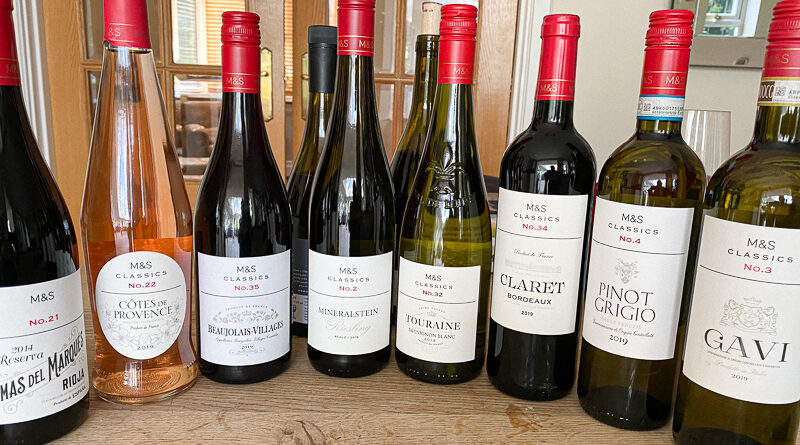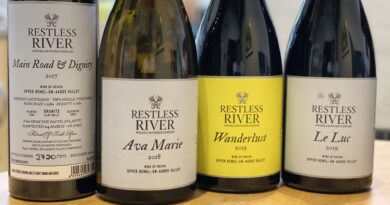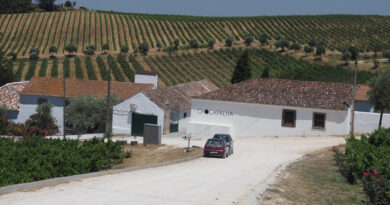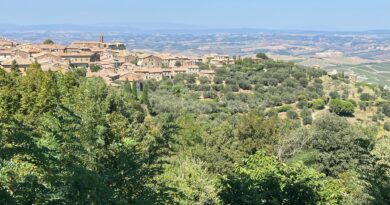The new ‘Classics’ range from Marks & Spencer
UK retailer Marks & Spencer has made its biggest wine launch in recent years with a new range titled ‘Classics’.
These are priced at £7-12, and eventually there will be 34 wines in the range. Sixteen have just been launched, and there will be a couple of additions next month. These hail from the old world – the second wave of additions, from the new world, will come in September. I tasted some of the wines and interviewed the Marks & Spencer winemakers, buyers and a couple of the producers by Zoom to find out what makes this launch significant.
‘We have curated a range to help our customers navigate our 400-strong wine range,’ says Marks & Spencer winemaker Belinda Kleinig. ‘We started by picking out the best loved styles and regions, and then Sue [Daniels] and I embarked on a big project with the buyers to source the highest quality at the most accessible price range we could. We are working with some of our long-term producers, and we also worked with new suppliers with more expertise in specific regions, such as Paul Buisse in the Loire Valley and Carlos Serres in Rioja.’
The packaging is quite distinctive. ‘After sourcing the best wines we could, we then intentionally put them in regionally distinctive packaging with a nice heavy, high quality paper label, to help cement the authenticity message we are trying to get across,’ says Belinda. ‘It is all about a range of the best-loved wine styles and regions, but highlighted with the M&S confidence and assurance to make it easier for customers.’
These wines taste better than their price points, so I asked whether they have taken a margin hit for this range. ‘No, we haven’t,’ says Hazel Macrae, press officer for food and wine. ‘It speaks of the talent of the team.’
We were really conscious to try to stay typical to each region. What we didn’t want is all the red wines to taste the same, wherever they came from.
Sue Daniels, M&S winemaker
Gerd Stepp is the winemaker responsible for what I think is the best wine in the range, the Mineralstein Riesling. I asked him to tell me a bit more about this wine. ‘A lot of the grapes for the Mineralstein Riesling come from my own vineyards,’ he says – he’s recently taken over the vines his parents owned. ‘The parcels are quite small, scattered around, and the soil varies. We have limestone, loam and sandstone. The winemaking is pretty much the same for all the wines I am doing: it’s pretty low intervention. Modern presses, cold fermentation, sometimes with added yeast and sometimes without. The thing that’s different is that I leave them for a long time on lees. I ferment, top up the tanks, and two or three weeks later I give a small dosage of sulfur dioxide. The only filtration is just before bottling, so I get a bit more umami and weight. It helps the structure. This wine has minerality, it has acidity (pH is 3.1) and some umami character. The style is at the top end of dry with 8 g/l of sugar. In some vintages it might go up to 10/11.’
Hazel points out that in putting together this range, the team did a lot of benchmarking. ‘This was to make sure that the wines over-delivered, in a competitive category and competitive price points.’
‘This is how we came across a few new suppliers,’ says Belinda. ‘We are also really happy that a lot of the range comes from people who we have been working with for years.’
The classic Claret comes from Maison Sichel in Bordeaux. I quizzed Charles Sichel about the Claret. ‘In 1967 Maison Sichel established their own Bel Air winery,’ he says. ‘This was exceptional at the time: no one else in Bordeaux had this tool. It was built with the same thought process as they do in Alsace of Champagne, where the winery doesn’t own any vines, but we buy the grapes from about 50 or 60 growers. This covers about 300 hectares. We have a team of five enologists that follow these growers throughout the year. What is important is the quality of the grapes. If we have good quality grapes we are 85% of the way to making good wine. Our enologists will determine the picking date, the growers bring the grapes to us and we take over from there in the winery. It is always a challenge to make a very nice wine at an extremely competitive price. £7 in store is pretty good going and a lot of effort was put into that. We wanted to make sure the wine has that Claret classicism coupled with a modern touch of ripeness and fullness, and the sweetness of fruit which consumers at this level look for.’ The Claret is completely unoaked. ‘It is a classic Claret with a touch of modern fullness and soft fruit.’
‘For this particular wine we wanted something that had that fruit appeal,’ says Sue. ‘Something that wasn’t going to challenge customers too much, but make them a little bit curious to see that Bordeaux is different from the Rioja we do. We were really conscious to try to stay typical to each region. What we didn’t want is all the red wines to taste the same, wherever they came from. Which, sadly, would be possible to do with winemaking techniques these days. That wasn’t what we were trying to do with this range.’
THE WINES
M&S Classics No. 2 Mineralstein Riesling 2019 Pfalz, Germany
12% alcohol
£9.50 Marks & Spencer
Zesty and lively, this is a nicely concentrated Riesling with lovely lime and lemon fruit. It’s dry with nice peach and spice characters adding interest. There’s a lovely texture to this wine, with a touch of mint and herb on the finish. 91/100
M&S Classics No. 3 Gavi 2019 Piedmont, Italy
12% alcohol
£8 Marks & Spencer
Made from the Cortese grape, this is an intriguing, fresh, fruity white with attractive herb-tinged citrus fruit, with a touch of white peach. 86/100
M&S Classics No. 4 Pinot Grigio Delle Venezie 2019 Italy
12.5% alcohol
£7 Marks & Spencer
From the rolling hills of the Veneto region in northern Italy, this is crisp and zesty with lovely fruit: lemons, grapefruit and even some melon richness. This is really impressive with bright, appealing fruit. 87/100
M&S Classic No. 21 Lomas del Marques Reserva 2014 Rioja, Spain
14% alcohol
£9 Marks & Spencer
This is a richly flavoured, dense, fruit-driven Rioja with lovely sweet blackberry and black cherry fruit combining nicely with tar, spice and vanilla from the oak. There’s a reall immediacy to this wine: it’s lively and spicy, with some of the complexity of long barrel ageing as well as lots of fruit. 90/100
M&S Classics No. 22 Côtes de Provence Rosé 2019 France
13% alcohol
£8 Marks & Spencer
Nicely packaged this orange/pink Provence rosé has smooth, pure, rounded flavours of strawberry and a hint of cherry, too. It has a nice softness, with the fruit and subtle spicy notes meshing together well. 87/100
M&S Classics No. 32 Touraine Sauvignon Blanc 2019 Loire, France
13% alcohol
£8 Marks & Spencer
This is rounded, smooth and fruity with a stony, slightly grainy edge to the sweet pear and citrus fruit. There’s just a subtle hint of green herbal character and some chalkiness, but otherwise this is just about fruit. 86/100
M&S Classics No. 34 Claret 2019 Bordeaux, France
13.5% alcohol
£7 Marks & Spencer
This is supple and fresh with appealing blackcurrant and plum fruit, with a savoury, cedary twist, and a nice sweet finish. It’s unoaked, so I’m not sure where the cedary, savoury notes come from. Maybe it’s the methoxypyrazines? 84/100
M&S Classics No. 35 Beaujolais Villages 2019 France
13.5% alcohol
£8 Marks & Spencer
This is fruity and expressive with joyful raspberry and red cherry fruit. It’s a very direct, fruity wine. Nothing complicated: just a blast of red fruits and a bit of crunch on the finish. 86/100
Other wines in the range launched this month:
Classics Côtes du Rhône Villages, 2019, £7
Classics Prosecco, NV, £8
Classics Picpoul de Pinet, 2019, £8
Classic Corbières, 2019, £8.50
Classics Bourgogne Blanc, 2018, £9
Classics Vouvray Demi Sec, 2019, £9
Classics Barossa Chardonnay, 2019, £9
Classics Bourgogne Pinot Noir, 2018, £12
Classics Albariño, 2019, £9 (launching July)
Classics Soave Classico, 2019, £7.50 (launching July)




